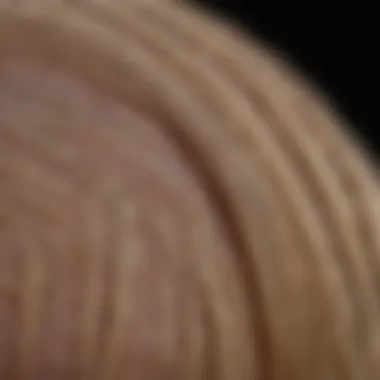New Treatment for Hair Regrowth: An In-Depth Overview


Intro
Hair loss is a complex condition affecting millions worldwide. Numerous factors contribute to this issue, including genetic predisposition, hormonal changes, and environmental influences. As a result, scientists and medical professionals have been investing resources into developing novel treatments for hair regrowth. This article aims to provide an in-depth overview of these treatments, highlighting their effectiveness and the underlying research that supports their use.
Recent advancements in medical technology and genetic research have paved the way for innovative solutions in hair restoration. The objective is not only to combat hair loss but also to enhance understanding of the biological processes involved in hair growth. By examining the latest evidence-based therapies, this overview serves as a critical resource for those seeking actionable information regarding hair regrowth treatments.
Understanding the mechanisms behind hair loss can illuminate the path toward effective solutions. For instance, disruption in the hair growth cycle and follicle miniaturization are key factors affecting many individuals. Recent studies highlight the importance of addressing these issues through scientifically backed methods.
As we explore these new treatments, we shall synthesize current research to shed light on their efficacy and implications for future developments in the field. This approach will assist readers, whether students, researchers, or professionals, in navigating the landscape of hair restoration therapies.
Understanding Hair Loss
Understanding hair loss is essential for both individuals experiencing thinning hair and for those seeking solutions to combat the problem. Hair loss not only affects one’s appearance but it can also significantly impact self-esteem and overall mental health. By comprehending the underlying mechanisms and types of hair loss, better decisions can be made regarding treatment options.
The human hair growth cycle is a complex process involving several phases. It is important to recognize that hair is not static; it goes through cycles of growth, rest, and shedding continuously. This biological process has implications for both the understanding of hair loss and the effect of various treatments.
Moreover, recognizing the common types of hair loss can aid people in identifying their specific condition. These classifications are crucial in tailoring the right therapeutic approaches. From androgenetic alopecia to alopecia areata, knowing the type facilitates effective intervention.
Finally, exploring the causes behind hair thinning and loss is critical. Factors like genetics, medical conditions, and nutritional deficiencies play pivotal roles. Each aspect contributes uniquely to the challenges of hair regrowth treatments. This understanding forms the groundwork for exploring more advanced treatments aimed at promoting hair regrowth.
Emerging Treatments for Hair Regrowth
The quest for effective hair regrowth treatments has intensified in recent years. New insights into the biological factors influencing hair loss have prompted the development of advanced therapeutic options. This section aims to dissect the importance of emerging treatments and their relevance in the broader context of hair restoration.
Emerging treatments are significant due to their potential to address hair loss with greater efficiency than traditional methods. The innovations in this field not only provide hope for individuals suffering from various types of hair loss, but also improve the quality of life for many. Moreover, the scientific community is increasingly focusing on individualized treatment plans, making therapy more tailored to specific needs. This means therapies can be selected based on the underlying cause of hair loss, enhancing success rates.
As research continues to evolve, the understanding of hair biology becomes more sophisticated. This aids in the design of treatments that not only stimulate regrowth but also ensure the long-term health of hair follicles. Continuous trials and studies are crucial for validating the efficacy of these treatments and may lead to groundbreaking solutions.
Overview of Current Therapeutic Options
Currently, numerous therapeutic options are available for hair regrowth, ranging from topical treatments to more technologically advanced interventions. These therapies seek to halt hair loss and stimulate regrowth by different mechanisms.
- Topical Minoxidil. Widely known and available over-the-counter.
- Oral Finasteride. Prescription drug primarily for men.
- PRP Therapy. A newer procedure utilizing patient’s blood.
- Low-Level Laser Therapy. Emerging trend using light therapy.
Each of these therapeutic options has unique mechanisms of action, utilization processes, and varying levels of efficacy.
Minoxidil: Mechanism and Usage
Minoxidil is a topical agent that has shown significant results in hair regrowth. This medication operates primarily by dilating blood vessels in the scalp, which enhances blood flow. By promoting vascularization, it increases the availability of nutrients and oxygen to hair follicles. This rejuvenates the hair growth cycle.
Usage typically involves applying the solution directly to the affected areas of the scalp twice daily. Results can take several months to appear, with consistent usage being critical. While Minoxidil is effective, it is essential to follow the prescribed method to avoid any potential side effects. Moreover, the treatment requires continual application; discontinuation may result in the loss of newly grown hair.
Finasteride: Efficacy and Considerations


Finasteride, commonly known under the brand name Propecia, is an oral medication effective primarily for male pattern baldness. It works by inhibiting the enzyme type II 5-alpha reductase. This enzyme converts testosterone to dihydrotestosterone (DHT), a hormone directly linked to hair follicle shrinkage.
The efficacy of Finasteride is well-supported by scientific studies. Users often observe a halt in hair loss after several months, with some regrowth on the crown of the scalp. However, it comes with considerations, including possible side effects such as sexual dysfunction. Thus, consulting a healthcare provider is crucial before beginning treatment.
Platelet-Rich Plasma (PRP) Therapy
Platelet-rich plasma therapy involves drawing a small amount of the patient’s blood and processing it to concentrate platelets. The resultant PRP is injected into the scalp to stimulate hair follicles.
PRP contains growth factors that promote healing and regeneration in tissues. The procedure is minimally invasive, and patients typically experience little downtime. Multiple sessions are often required to see optimal results, making this a longer-term commitment. Additionally, PRP therapy is gaining traction due to its natural origins, as it utilizes the body’s own components.
Low-Level Laser Therapy (LLLT)
Low-level laser therapy offers another innovative approach to hair regrowth. This technique involves the application of lasers to the scalp. The laser light stimulates cellular activity in hair follicles, enhancing energy production and promoting hair growth.
Clinical studies have reported positive outcomes, although results may not be as pronounced as with other treatment options. One advantage of LLLT is that it is non-invasive and can be used alongside other treatments. It is crucial to use devices that are FDA-cleared to ensure safety and effectiveness.
"Understanding and considering diverse therapeutic options is essential for informed decision-making in hair restoration."
As emerging treatments advance, it is vital to remain informed about their mechanisms, benefits, and limitations. By exploring these avenues, individuals can make better choices in their hair regrowth journey.
Recent Innovations in Hair Restoration
Recent advancements in hair restoration represent a crucial juncture in the ongoing endeavor to tackle hair loss. These innovations not only promise enhanced efficacy but also aim to address the underlying causes of hair thinning. Given the emotional and psychological toll of hair loss, the importance of these developments cannot be overstated. Patients seeking solutions are inclined to explore treatments that harness the latest scientific discoveries, enhancing their quality of life and confidence.
Stem Cell Therapy in Hair Regrowth
Stem cell therapy is emerging as a promising option for hair regrowth. This method utilizes the body’s own stem cells to promote hair follicle regeneration. By harnessing the regenerative capabilities of stem cells, researchers aim to create an environment conducive to hair growth. Early studies indicate that this treatment can significantly improve hair density in individuals experiencing hair loss. However, its full potential has yet to be realized, and ongoing research is required to determine the ideal application methods and treatment protocols.
Gene Therapy: A Promising Approach
Gene therapy stands at the forefront of innovative hair restoration techniques. This approach targets the genetic factors that contribute to hair loss. By introducing or modifying genes responsible for hair growth, scientists hope to reverse the condition. Preliminary trials have shown encouraging results, indicating that gene therapy can effectively stimulate hair follicles. While still largely experimental, this method presents a fascinating avenue for addressing genetic alopecia, providing hope where traditional treatments have fallen short.
Bioengineered Hair Follicles
Bioengineered hair follicles represent a significant leap in hair restoration technology. Researchers are working to develop artificial hair follicles that can mimic natural hair growth. This technique involves cultivating hair follicle cells in a lab setting, which can then be implanted into areas of the scalp affected by hair loss. Early trials have indicated that these bioengineered follicles can successfully integrate with existing scalp tissue, offering a viable alternative to conventional transplantation methods. The goal is to create a stable supply of hair follicles that can be used for transplantation, thereby alleviating the limitations posed by donor site availability.
These innovations in hair restoration could reshape the future of treatment options available to those suffering from hair loss. Understanding them is essential for practitioners and patients alike.
Efficacy and Evidence of Treatments
The assessment of efficacy and evidence in hair regrowth treatments is critical for understanding the effectiveness of various options available. Establishing the veracity of these treatments involves examining rigorous clinical trials, scrutinizing success rates, and evaluating real-life patient testimonials. This section aims to highlight the importance of evidence-based approaches in hair restoration, illustrating that informed decisions are crucial for individuals facing hair loss.
Clinical Trials and Studies


Clinical trials are essential to validate new treatments. They allow researchers to systematically evaluate how well a treatment works in controlled environments. A variety of studies have been conducted on both established and emerging hair regrowth therapies.
For example, studies around Minoxidil and Finasteride demonstrate significant results. These trials often compare active treatment groups with placebo groups, ensuring that results are not due to chance. The findings tend to provide insight into improvements in hair density and overall scalp health. Clinical evidence supports that these treatments induce hair regrowth in a notable percentage of users. However, effectiveness may vary based on individual response, severity of hair loss, and adherence to treatment protocols.
Success Rates of Various Treatments
Success rates are a vital component when evaluating hair restoration methods. These figures not only reflect how many individuals experience noticeable improvement but also shed light on overall satisfaction with the treatment.
- Minoxidil: This topical treatment has reported a success rate of approximately 40% to 60% after several months of consistent use. Factors like concentration and type play a role in these rates.
- Finasteride: Clinical studies indicate that about 80% of men using Finasteride see a halt in hair loss, with nearly half regrowing some hair within a year.
- Platelet-Rich Plasma (PRP): Initial studies on PRP report positive outcomes in around 70% of participants in terms of hair thickness and regrowth following multiple treatment sessions.
While these success rates are promising, understanding the individual nuances of hair loss is critical. Each treatment may yield different results depending on the user's unique circumstances and adherence.
Patient Experiences and Testimonials
Patient testimonials provide invaluable insight into the real-world effectiveness of hair regrowth treatments. These stories often highlight individual experiences that trials cannot fully capture.
Many patients share success stories about improvements after using medications such as Minoxidil and Finasteride. The emotional aspect of hair loss often comes through in these testimonials, with subjects discussing increased confidence and satisfaction with their appearance.
However, caution is warranted. Not all experiences are positive. Some individuals report minimal or no results from treatments, emphasizing the variability in person to person response. It is essential for prospective users to consider these factors carefully.
"Understanding the balance between expectations and reality is essential in managing hair loss treatment outcomes."
Challenges in Hair Regrowth Treatments
The quest for effective hair regrowth treatments is complex and multifaceted. Despite advances in therapeutic options, individuals often encounter significant challenges during their journey. Understanding these obstacles is essential for anyone considering hair restoration techniques. This section will outline the major hurdles: resistance to treatments, side effects, and cost implications related to hair regrowth therapies.
Resistance to Treatments
Resistance to treatment is a notable issue in the field of hair restoration. Many individuals find that standard therapies such as Minoxidil and Finasteride may lose their effectiveness over time. It is believed that this resistance can stem from several factors, including:
- Genetic predisposition of hair follicles.
- The natural progression of hair loss, which can alter hair's response to treatments.
- Inconsistent application of products or failure to adhere to treatment protocols.
Research shows that understanding the biological mechanisms behind resistance can improve treatment strategies. Identifying personalized approaches may offer significant breakthroughs, making this topic a focal point in ongoing research. By addressing the underlying causes of resistance, more successful and sustainable treatment plans can be developed.
Side Effects and Safety Profiles
Side effects associated with various hair regrowth treatments must not be overlooked. While products like Finasteride can be effective, they also come with potential side effects, which might include:
- Erectile dysfunction
- Decreased libido
- Mood changes
On the other hand, Minoxidil can cause scalp irritation and unwanted facial hair growth. These side effects raise concerns about the safety profiles of hair restoration methods. It is crucial for users to weigh the benefits against these risks before committing to a treatment. Moreover, ongoing monitoring and studies on long-term safety are necessary to ensure that users can make informed decisions about their hair regrowth options.
Cost Implications and Accessibility


Cost is another significant challenge that many people face when seeking hair regrowth treatments. This area can vary widely depending on the type of treatment chosen and where it is obtained. Considerations include:
- Prescription medications such as Finasteride may have ongoing costs that can add up over time.
- Procedures like PRP therapy or hair transplants are often expensive and may not be covered by insurance.
- Accessibility to advanced treatments is sometimes limited by geographic location, making it difficult for some individuals to access cutting-edge therapies.
These economic barriers highlight the need for affordable and accessible solutions in hair regrowth. Advocating for more inclusive healthcare options can help make treatments available to a broader audience, ultimately enhancing the overall well-being of those experiencing hair loss.
"Understanding these challenges is the first step towards developing effective solutions in hair restoration."
Recognizing the barriers in hair regrowth treatments is fundamental. Addressing resistance, understanding side effects, and tackling cost issues can pave the way for more effective and accessible options for those seeking to restore their hair.
Future Directions in Hair Regrowth Research
The field of hair regrowth research is advancing rapidly, with significant implications for treatment strategies. With the combined efforts of scientists and researchers, new avenues are being explored that may change the landscape of hair restoration. The significance of this topic lies in the potential to offer innovative solutions to those struggling with hair loss.
Advancements in Genetic Research
Genetic research is pivotal in understanding and addressing hair loss. Variants in specific genes have been linked to androgenetic alopecia and other forms of hair thinning. Recent studies look at genetic predispositions that influence hair follicle biology. The goal is to identify target genes for therapeutic intervention.
By leveraging techniques like CRISPR, scientists hope to correct genetic mutations responsible for hair loss. Successful localization of these genes could enable precise therapies tailored to individual patient's needs. Understanding the genetic basis can lead to earlier detection, allowing interventions to begin well before hair loss becomes noticeable.
Integration of Artificial Intelligence
Artificial intelligence (AI) is transforming multiple domains, and hair restoration is no exception. With the analysis of extensive datasets, AI can help in predicting patterns of hair loss. Machine learning algorithms can assist in identifying which treatments work best for specific genetic backgrounds.
Moreover, AI can develop personalized treatment plans by analyzing a patient's unique hair characteristics. Additionally, AI-powered tools may improve early detection of hair loss, allowing for timely interventions. By optimizing treatment strategies, AI enhances overall outcomes for individuals seeking hair regrowth solutions.
New Drug Development
New therapeutic agents are essential for advancing hair regrowth treatments. Current medications often have limitations in terms of efficacy and side effects. Therefore, pharmaceutical research is focusing on developing innovative drugs that target multiple pathways involved in hair regeneration.
Researchers are exploring various compounds, including those derived from herbal sources, which have shown promise in stimulating hair follicles. For instance, researchers are investigating the potential of topical applications that can enhance scalp health or inhibit specific hormones linked with hair loss. Furthermore, drug delivery systems that enhance absorption are also in the pipeline, increasing the likelihood of effective treatments reaching the targeted site.
End
The conclusion of this article serves as a synthesis of key information regarding hair regrowth treatments. Understanding hair loss and the available solutions has become increasingly essential in today’s society. In light of evolving treatment methods, this article highlights significant advancements that address the complexities of hair loss. By reviewing various scientific studies and emerging innovations, readers gain insight into the proven efficacy of specific treatments.
Recap of Key Points
In summarizing the main aspects discussed in the article, it’s clear that:
- Understanding Hair Loss is Crucial: Knowledge of the hair growth cycle and types of hair loss lays the groundwork for exploring treatment options.
- Diverse Treatment Modalities: From Minoxidil to PRP therapy, there are numerous approaches available, each with its mechanism of action and evidence supporting its use.
- Innovation in Hair Restoration: Developments such as stem cell therapy and bioengineered hair follicles represent the forefront of research, suggesting a promising future.
- Evidence of Efficacy: Clinical trials have demonstrated varying success rates, making it critical for patients to review their options based on scientific evidence.
- Challenges Persist: Factors such as treatment resistance and safety concerns continue to complicate the landscape of hair regrowth therapies.
Implications for Future Hair Loss Solutions
The exploration of future directions in hair regrowth research carries significant implications. Advancements in genetic research and the integration of artificial intelligence promise to refine treatment effectiveness and tailor individual patient care. New drug developments hold the potential to offer more targeted therapies as our understanding of hair biology evolves.
Moreover, as the stigma around hair loss decreases, there is a growing market for effective solutions. Patients are likely to demand more nuanced, personalized treatments that consider their unique genetic makeup and medical history. The future of hair regrowth solutions may very well hinge on continued innovation and a collaborative approach between researchers, healthcare providers, and patients in the pursuit of effective therapies.
"The landscape of hair regrowth treatments is continually changing. Staying informed about the latest scientific advances is essential for anyone affected by hair loss."















